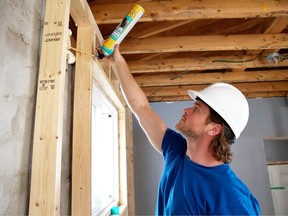
With the temperature dropping, many homeowners may be thinking about how they can keep their homes warm and cozy, and some of that goes back to their home’s insulation. But insulation isn’t just about keeping your home warm in the winter and cool in the summer — it’s also about energy efficiency, comfort and protecting your house from the elements. So, what are some of the ways we can improve insulation?
Advertisement 2
Article content
To start, you need to know what type of insulation you have. There are a few different types of insulation materials (fiberglass, polystyrene, mineral wool, etc.). Each has its pros and cons. Fiberglass is a popular choice, and it’s affordable. Cellulose is made from recycled paper and is environmentally friendly. Foam insulation provides excellent sealing properties, but is more expensive.
Article content
Inspect your home for areas where insulation might be lacking or damaged. Look for drafts, cold spots and signs of moisture or mold. Common areas like the attic, walls, floors and the basement need attention as our homes get older.
Sealing leaks and adding insulation can improve the overall comfort of your home. It can also reduce noise, limit pollen, dust and insect or pest intrusion, provide better humidity control, and lower the chance of ice damage on the roof during winter.
Advertisement 3
Article content
You must seal all the areas in your home where there is air leakage and drafts before adding more insulation. Seal gaps and cracks around doors, windows, electrical outlets and other openings with weatherstripping, caulk and expandable foam where possible.
The cost of heating and cooling accounts for about half of your energy expenditure. Attics, floors, crawl spaces and accessible basement rim joists can all benefit from insulation, which can help you save up to 20 per cent on your home’s heating and cooling expenses or up to 10 per cent on its overall energy costs.
Adding extra insulation to your attic will make a difference. I advise adding extra insulation if the attic’s insulation is less than the equivalent of R-30 (about 10 to 13 inches/25 to 33 cm). It’s well worth the money to upgrade an under-insulated home. Fiberglass batts, blown-in cellulose or foam insulation are good options. Ensure the insulation is evenly distributed, and vented properly to prevent moisture buildup, mold and mildew.
Advertisement 4
Article content
Insulating walls is a bit more challenging. Insulating unfinished basement walls, especially in older homes, is a great way to improve your home’s efficiency. Again, fiberglass batts, foam boards or spray foam are all excellent options. For existing walls, consider blown-in insulation or even exterior insulation options.
Exterior-wall insulation is an effective but expensive option. Extra time is required to excavate, repair foundation cracks, or waterproof the exterior foundation walls. Basement walls can be insulated using rigid mineral wool boards, high-density polystyrene and polyurethane/polyisocyanurate boards.
Heat losses and drafts can occur around windows and doors. Ensure you apply weatherstripping or caulking to fill any gaps or cracks. High expansive foam is excellent for sealing around windows and doors. If you have old windows, replace them with more energy-efficient ones. Good options are double or triple-glazing, low-E coatings and gas-filled glass. The correct installation will improve your home’s energy efficiency and insulation.
Advertisement 5
Article content
Don’t forget about your floors. If you have a crawl space or unfinished basement, you can insulate the floor above to prevent heat loss. You can also use fiberglass batts or foam board insulation, but correct installation is critical for optimal performance, and creating a continuous barrier.
Insulated siding is an exterior cladding option that adds a layer of insulation to the exterior of your home. It can improve your home’s efficiency and protection from the elements. This is a costly option but effective; however, proper installation is essential to ensure no moisture penetration occurs.
Ensure your ductwork is sealed with mastic or foil tape and insulated correctly to reduce heat loss. Leaky ducts can waste a significant amount of energy.
Advertisement 6
Article content
If you have any concerns about your home’s insulation, consult a professional. An energy audit performed by a certified home energy auditor can identify specific issues and recommend the most effective solutions. Complex installations like spray foam or exterior insulation are best left to the pros. They will also ensure your home is properly ventilated to help prevent mold and mildew growth.
An energy auditor will also assist you with any rebates or incentives. You can also check with your local building office to ensure you are in compliance with local codes.
After you’ve improved your insulation, perform regular maintenance checks, and monitor your energy bills to see the impact of your efforts. Improving your home’s insulation is a wise investment that pays off in terms of energy savings, comfort and overall performance.
Article content
Comments
Postmedia is committed to maintaining a lively but civil forum for discussion and encourages all readers to share their views on our articles. Comments may take up to one hour for moderation before appearing on the site. We ask you to keep your comments relevant and respectful. We have enabled email notifications—you will now receive an email if you receive a reply to your comment, there is an update to a comment thread you follow or if a user you follow comments. Visit our Community Guidelines for more information and details on how to adjust your email settings.